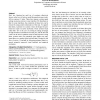Free Online Productivity Tools
i2Speak
i2Symbol
i2OCR
iTex2Img
iWeb2Print
iWeb2Shot
i2Type
iPdf2Split
iPdf2Merge
i2Bopomofo
i2Arabic
i2Style
i2Image
i2PDF
iLatex2Rtf
Sci2ools
CHI
2005
ACM
2005
ACM
Breaking the laws of action in the user interface
Fitts' law, Steering law and Law of crossing, collectively known as the laws of action, model the speed-accuracy tradeoffs in common HCI tasks. These laws impose a certain speed ceiling on precise actions in a user interface. My hypothesis is that for some interfaces, the constraints of these laws can be relaxed by using context information of the task. To support this thesis, I present two systems I have developed for penbased text input on stylus keyboards. These systems break either Fitts' law or the Law of crossing by taking advantage of high-resolution information from the pen, and the fact that words can be seen as patterns traced on the keyboard. Using these systems users can potentially gain higher text entry speed than on a regular stylus keyboard that is limited by the laws of action. I conclude by discussing planned future research, primarily improved visual feedback and empirical evaluation. Categories & Subject Descriptors: H.5.2 [Information Interfaces and ...
Certain Speed Ceiling | CHI 2005 | Human Computer Interaction | Regular Stylus Keyboard | Text Entry Speed |
| Added | 30 Nov 2009 |
| Updated | 30 Nov 2009 |
| Type | Conference |
| Year | 2005 |
| Where | CHI |
| Authors | Per Ola Kristensson |
Comments (0)

